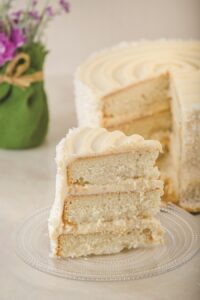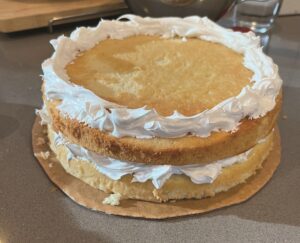My grandmother possessed a solid repertoire of braises, etouffeés, and gumbos. Her fried chicken set the gold standard to which I still aspire. She must have cooked her way through these dishes thousands of times, more out of obligation than joy. But for my brothers and me, she worked magic in the kitchen.

In her recipe collection were only three desserts: banana pudding, pecan pralines, and a majestic coconut cake that appeared on the most special occasions. It always crowned Easter dinner. When we were small, she would fashion the layers into the shape of a bunny, adding jellybeans for its eyes and nose.
We called my grandmother “Mt. Agnes” — she was the quiet, solid center of our family. No matter what chaos the world threw at us (or that we generated ourselves) she was a steadfast presence. Even in the worst of times, when our capacity to celebrate faltered, the cake appeared, tall and insistent.

As I grew into adolescence, hungry for a life larger than the one possible in rural Louisiana, the magic began to wear off. I rolled my eyes at the now too-familiar cake: “What a surprise — coconut cake.”
My grandmother saw this. But if it stung, she didn’t show it. She encouraged me to go out and live my life. I did, returning less often than she hoped. Still, the cake continued to anchor special occasions.
One Easter a sad, squat store-bought cake appeared instead of hers. My grandmother made light of it, but there was sadness in her voice. I saw her frailty for the first time. The cake was gone. Mt. Agnes would not stand forever.
My mother found the handwritten cake recipe after her death, and I asked for a copy. It’s become my go-to for celebrations like Christopher’s birthday or the wedding supper of our friends Ericka and Rosa. The old-fashioned yellow cake layers, the luscious custard, and, especially, the pillowy seven-minute boiled icing (more glamorously known as Italian meringue) herald special occasions like no other dessert I know.
While it has several steps, the cake is not really difficult to make. I’ve tinkered with the recipe, replacing milk with coconut milk in the cake layers to intensify the flavor. If I have some on hand, I use cake flour in a one-to-one mix with all-purpose flour for a lighter cake, but it’s not crucial.

The layers may be baked ahead, wrapped tightly in plastic wrap, and stored in the refrigerator for a couple of days, or even frozen for a month or so. The custard may also be prepared a day ahead, but the boiled icing is best prepared on the day the cake will be served.
I like to think that my grandmother would be glad that I’ve taken up the coconut cake tradition and taken to heart the lesson that so much of life consists of showing up and having a great cake in the wings to celebrate, no matter what.
Agnes Bouquet’s Coconut Cake
Makes a 9-inch 3-layer cake
For the cake
3 cups all-purpose flour
1 Tbsp. baking powder
½ tsp. fine salt
2 cups sugar
¾ cup unsalted butter at room temperature
¼ cup canola oil
1 1/3 cups unsweetened coconut milk
2 large egg yolks at room temperature
1 tsp. coconut extract
½ tsp. vanilla extract
6 large egg whites at room temperature
1/8 tsp. cream of tartar
- Preheat the oven to 350° F. Butter and flour three 9-inch cake pans, line them with parchment paper, and butter and flour the paper, too.
- Sift flour, baking powder, and salt into a mixing bowl. In the bowl of a standing mixer, beat together sugar, butter, and canola oil until well combined and fluffy. Scrape down the sides of the bowl. Add the egg yolks one at a time and beat until combined. Add coconut and vanilla extracts, mix well, and scrape down the sides of the bowl again.
- Add a third of the flour mixture and mix until combined. Stir in half the coconut milk. Mix in another third of the flour mixture followed by the remaining coconut milk, then the last third of the flour mixture.
- Whip the egg whites and cream of tartar until stiff peaks are just formed (do not overwhip). Using a rubber spatula, carefully fold the egg whites into the cake batter, a third at a time, until just combined.
- Divide the batter among the prepared pans, smoothing it with a spatula. Bake about 20 minutes, just until the temperature registers between 200 and 209° F on an instant-read thermometer. Allow the layers to cool in the pans for 10 minutes, then run a knife along the edges of the cakes and invert onto a wire rack to cool completely.
For the coconut custard
2 egg yolks
6 Tbsp. sugar
2 Tbsp. cornstarch
1½ cups whole milk
1 cup shredded sweetened coconut
1 Tbsp. unsalted butter
¼ tsp. coconut extract
¼ tsp. vanilla extract
- Gently beat egg yolks in a small bowl and set aside.
- Whisk together the sugar, cornstarch, and milk in a heavy saucepan. Slowly heat until the mixture begins to bubble and thicken. Remove the pan from the heat.
- Add a tablespoon or two of the thickened milk mixture to the egg yolks, whisking to temper the yolks and prevent them from scrambling. Then add the tempered yolks to the saucepan and return it to medium heat.
- Add shredded coconut and stir, allowing the custard to just come to a boil. Continue stirring for 1 minute to further thicken and then remove from heat. Add butter and extracts and stir until smooth.
- Pour into a bowl and cover with plastic wrap pressed against the custard to prevent the formation of a skin. Refrigerate to cool completely.
For the seven-minute boiled icing
1½ cups sugar
2/3 cup water
Large pinch cream of tartar
Large pinch of fine salt
3 egg whites at room temperature
1 tsp. vanilla
2 to 3 cups shredded coconut
- Combine sugar, water, and cream of tartar in a saucepan and bring to a boil. Do not stir once the mixture begins to warm, as that could cause the sugar to crystallize. Boil until the sugar reaches 245° on an instant-read thermometer.
- Meanwhile, whisk the egg whites and salt in the bowl of a standing mixer until they form soft peaks. Once the sugar syrup has come to temperature, turn the mixer to low and slowly pour the sugar syrup into the egg whites. Once the sugar syrup has all been added, turn the mixer to high and beat for 7 minutes, until the icing is fluffy and glossy and the sides of the bowl are cool. Do not overbeat. Beat in the vanilla extract.
The cake assembly
- With a serrated knife, even the tops of the cake layers by slicing off the domes. Place the first cake layer on a piece of cardboard or serving plate, then use a spatula or pastry bag to create a dam of frosting around the outer edge of the layer. The dam prevents the custard from seeping out from between the layers.
- Spread half the coconut custard evenly on the first layer, inside the dam. Add the second cake layer, create another frosting dam, and spread with the remaining custard.
- Add the final cake layer and frost the top and sides of the cake. Immediately after frosting, gently press the shredded coconut around the sides (or sides and top) of the cake.



